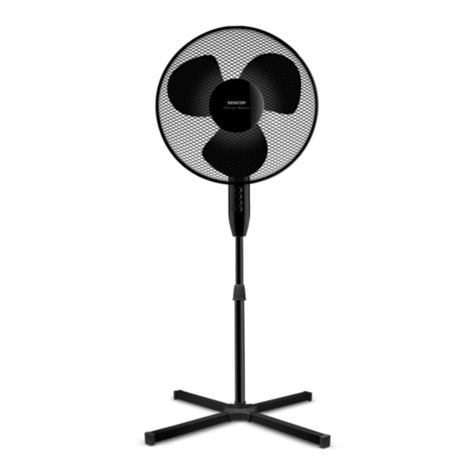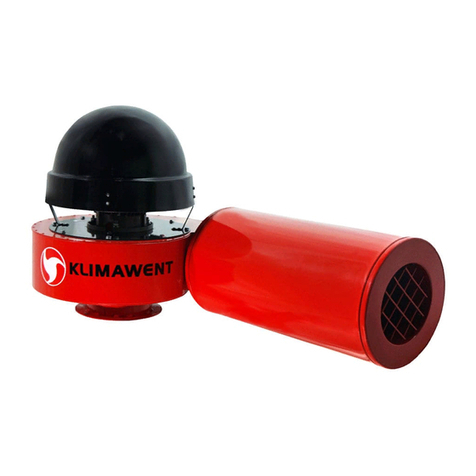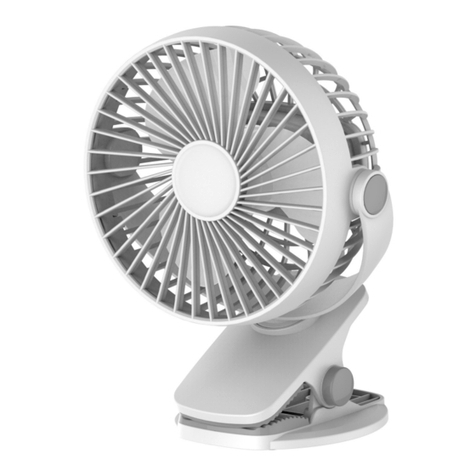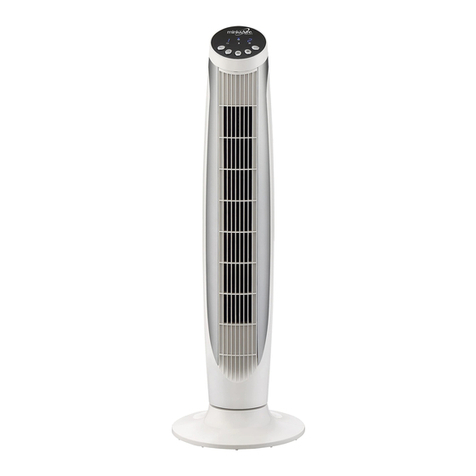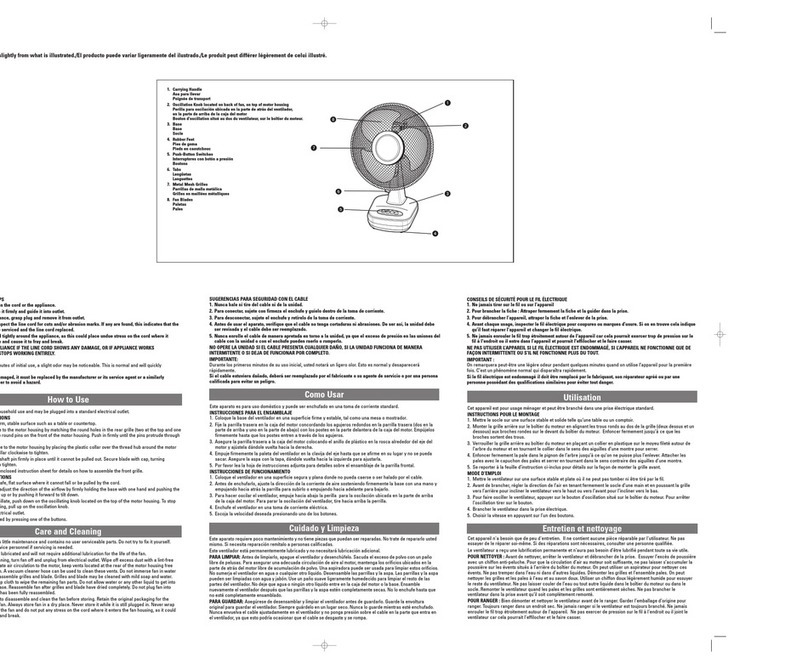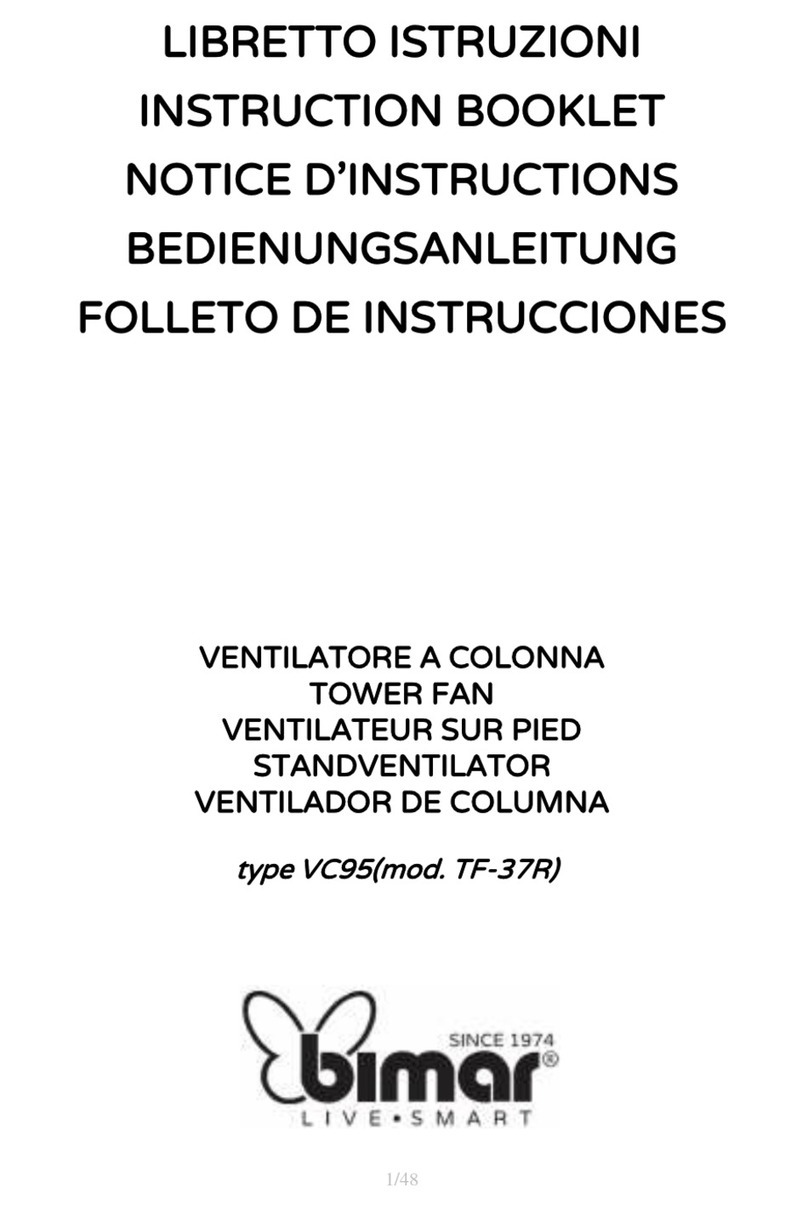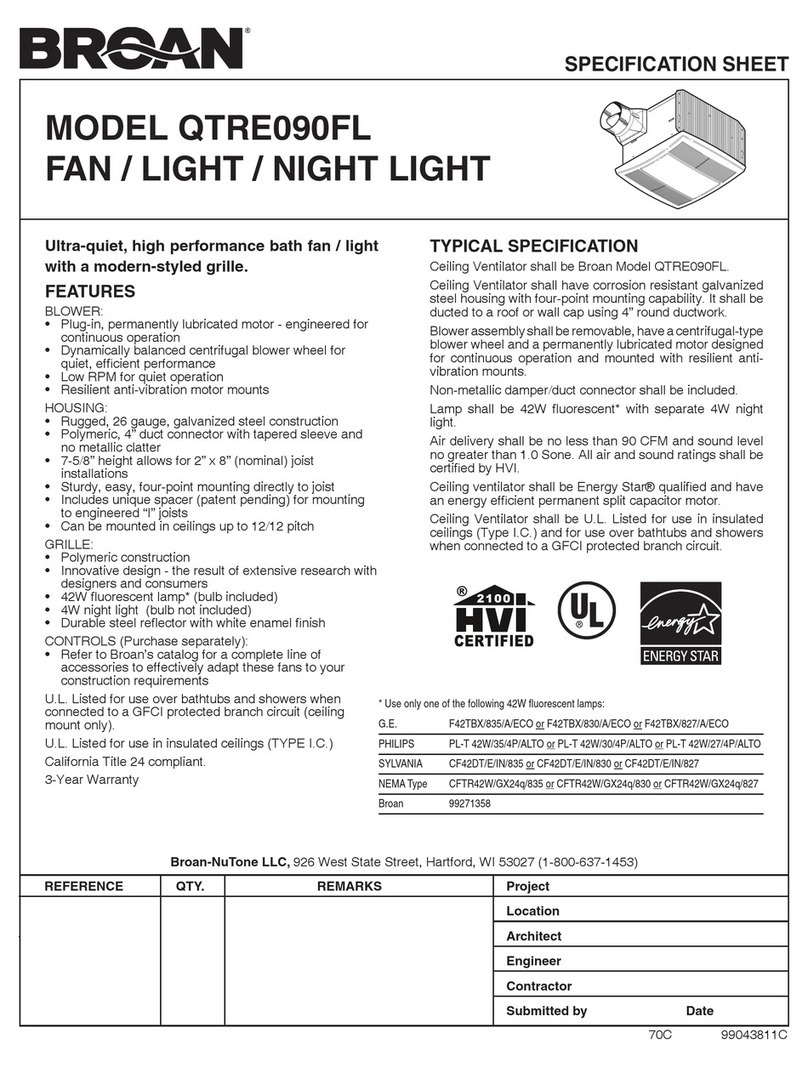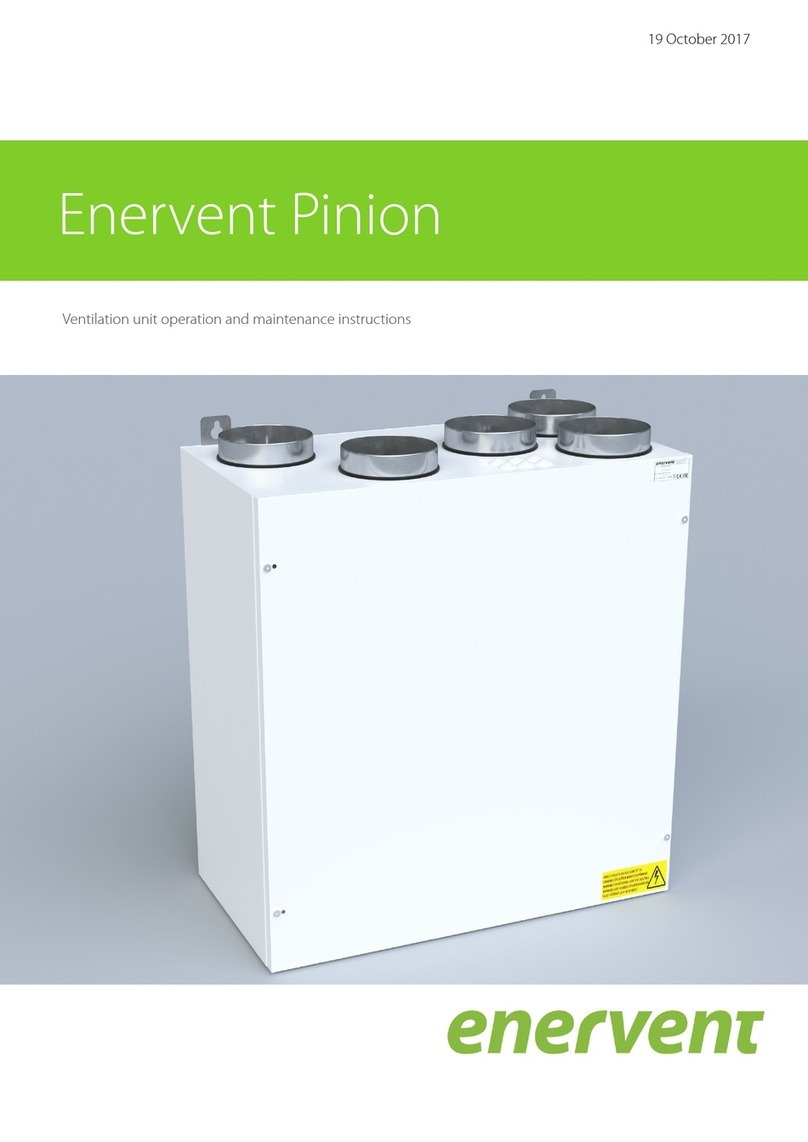Amano EM-e II User manual

Thank you for your purchasing the Amano electrical
collection type mist collector, EM-eⅡseries. It is important
to read the operation manual carefully before using the
dust collector in order to operate it safely and correctly.
A
lso, make sure to keep the manual close at hand so that
you can refer to it when necessary.
Important
◎Read thoroughly "1. For Safe Operation" in the page 3 to 7
and use the equipment correctly.
◎Follow all operation and maintenance instructions and
carry out the daily and periodic inspections as specified in
this manual.
◎Observe all applicable laws and regulations regarding the
installation and maintenance of the dust collector.
◎This manual is compiled for the model with standard
specifications. In the case that change is made for custom
specifications based on customer's request, the design
and operation style of such model may differ from those
described in this manual.
Name of parts ●
8
Preparation ●
10
Operation ●
17
Maintenance ●
28
Troubleshooting ●
47
Electrical collection type mist collector
EM-e
OPERATION MANUAL
Production date: May 2015
Page
Ⅱ

1
Table of contents
1.For safety operation............................................................. 3
2. Name of parts ................................................................... 8
External view...................................................................................................................................8
Control panel...................................................................................................................................9
3.Preparation ................................................................... 10
Installation ................................................................................................................................... 10
Oil drainage................................................................................................................................. 12
Installing ducting.......................................................................................................................... 13
Connecting to the power supply ..................................................................................................15
Checking the rotation direction of motor...................................................................................... 16
4.Operation ..................................................................... 17
Checking before use ................................................................................................................... 17
Starting and stopping the operation.............................................................................................17
Connecting the wires for the external operation .......................................................................... 18
Setting of data ............................................................................................................................. 22
Mode setting................................................................................................................................ 23
High voltage delay setting ........................................................................................................... 24
Setting of continuous operation of Fan........................................................................................ 25
Maintenance timer setting ........................................................................................................... 26
External operation setting............................................................................................................ 27
5. Maintenance ................................................................... 28
Display of message window ........................................................................................................ 28
Error message display................................................................................................................. 29
Error cancellation ........................................................................................................................ 31
Reset of the thermal relay ........................................................................................................... 32
Key points of inspection .............................................................................................................. 33
Opening and closing the inspection door .................................................................................... 34
Inspection of the eliminator ......................................................................................................... 35
Inspecting the charging electrode ...............................................................................................36
Inspecting the collecting electrode .............................................................................................. 38
Important matters of cleaning the collecting unit ......................................................................... 39
Cleaning of the eliminator............................................................................................................ 40
Cleaning of the charging electrode..............................................................................................41
Cleaning of the collecting electrode ............................................................................................43
Importantmattersofcleaningtheproductandpipes.................................................................................... 45
Cleaning inside of the mist collector............................................................................................ 45
Cleaning inside the pipes ............................................................................................................ 46
6. Troubleshooting ............................................................... 47
7. Periodic inspection ........................................................... 48
8. Specification ................................................................. 49
Model .......................................................................................................................................... 49
9. External dimensions ........................................................... 50
10. Wiring diagrams .............................................................. 52
11. Expendable parts ............................................................. 53
12.About dust collector disposal of the product ...................................... 53

2
Foreword
This product is an electrical collection type mist collector using high
voltage to collect both oily mist and water-soluble mist from
metalworking
●This machine is designed for the purpose in collecting oil mist generated from the metal machining
process of machining centers or NC tooling machines. However, the machine is not applicable to the
oil mist which includes a lot of dust (1 %and more in weight ratio), strong alkaline mist, strong
acidic mist, or solvent mist, metal fume from meltdown.
●This product cannot be used for the explosive and inflammable substance and the substance
described in the next page “△Danger”.
●This operation manual describes about the standard specifications. Custom-order could differ the
contents such as external dimensions and performance.
●The specifications , appearance of the dust collector and the description in this manual are subject to
change due to improvements.
●For notes on the suctioning requirements, refer to Page 7.
●The illustration inside the manual is drawn based on EM-15eⅡ. Other machine could differ the
contents.
A physical accident, failure, and/or property damage is not covered by our warranty if they occurred
by the use of it in the following manners.
・Fire and explosion in the mist collector caused by ignitability or inflammability of sucked mist.
・Improper operating conditions or usage different from that specified in this manual.
・Failure to maintain the mist collector or replace the consumable parts as specified in this manual.
・Any modification, repair, or equipment transfer performed by a third party or personnel not
authorized by AMANO.
・Natural disasters or calamities, such as fires, earthquakes, or floods.
・Any event that could not be predicted scientifically or technologically at the time of manufacture.
・Use of a secondhand mist collector.
・Other causes that are not the responsibility of AMANO.
Things to be acknowledged beforehand
Disclaimer

3
1.For safety operation
Precautions in this manual are classified according to degree and type of danger, as shown below. Be
sure to read them before operating the mist collector.
• Serious injury refers to loss of eyesight, wounds, burns (high temperature, low temperature), electric shock,
bone fracture, poisoning, etc. which have lasting effects or require hospitalization or long-term outpatient
treatment.
• Injury refers to wounds, burns, electric shock, etc., which do not require hospitalization or long-term outpatient
treatment.
• Property damage refers to extensive damages to houses, properties, equipment, devices, etc.
Examples of pictorial symbols
Never install the mist collector in a
dangerous place specified by law,
regulations, etc.
Failure to do so could cause fire and ex
p
losion.
Never operate the mist collector in or
near an area where inflammable,
explosive particles or corrosive mist,
fumes or gases are present.
These gases could cause fires or explosions.
Never use it by any other power
voltage and frequency than those
indicated on the product. Also, do not
overload one electrical outlet by
connecting many plugs to it.
This could cause fire or electric shock.
Never touch the power cable with we
t
hands when connecting or disconnect-
ing it.
This could cause electric shock.
Never allow the power cable damaged
or broken. Never place heavy items on
the power cable, pull or bend it
excessively.
This could also cause fire or electric shock
Never make any modifications to this
mist collector.
This could cause fire or electric shock.
Never allow the following substance to
get into the mist collector.
・Explosive, flammable powder :Aluminum,
magnesium, titanium, epoxy, toner, etc
・Inflammable substance: Gasoline, thinner,
benzene, kerosene ,paint, etc.
・Dust with sparks: Dust produced by a high speed
cutter, grinder, welding machine, etc.
・Source of fire: Cigarette butts, ashes, etc.
・Other: Oil or mist with low flash point below to 80
degrees.
These substances could cause fire and explosion
The △symbol shows a
warning and caution.
The symbol shows a
compulsor
y
action.
Do not use an inflammable substance
(gasoline and kerosene, etc.) to clean
the collection unit and the main body.
Failure to do so could cause electric shock and fire.
The symbol shows a
prohibited action.
WARNING
Shows situations in which incorrect operation
could result in injury to the operator or propert
y
damage.
Shows situations in which incorrect operation
could result in death or serious injury to the
operator.
Do not install it at the place where
evaporation, dispersion or stagnation
of the following substances is likely.
・Inflammable substances…(such as gasoline,
thinner, benzene, or kerosene,etc.)
・Explosive material(such as nitroglycerine )。
・Ignitable substances( such as explosive metal
powder including aluminum and magnesium, red
phosphorus, and yellow phosphorus etc.)
・Inflammable fine particles(such as coal powder,
plastic powder, sulfur powder, and cornstarch
powder, etc.)
These substances could cause fire and explosion
Do not suck the following substances:
• Harmful powder, such as asbestos.
• Corrosive substances: Hydrochloric acid gas,
chlorine, a toxic gas with sulfide based compounds,
and hydrogen fluoride, etc.
• Dust polluted by radioactive substance or
radioactivity.
Failure to do so could affect
y
our health.

4
1.For safety operation(continue)
Important
●This mist collector can not be used for the following mists, because they may cause a fire or
accident:
・Oil mist which contains combustible dust with explosively such as carbon, magnesium, and/or
aluminum powder.
・Oil mist which contains a lot of dust(1%or more in weight ratio).
・Oil mist whose ignition is likely.
・Oil mist which may corrode this mist collector.
・Oil mist which is of high viscosity and may adhere in the mist collector.
・Oil mist which may adhere even in the allowable temperature range, 0 to 40℃)
・Soluble mist which has over 300mS/m of the electric conductivity
・Oil mist which has 200mg/m3 of the maximum concentration
・Oil mist which may pose adhesion due to the change of application conditions such as temperature,
moisture, and operation time.
Be sure to ground the mist collector.
If the equipment is not grounded, electrical leakage
occurs and there is a danger of fire or electric shock.
A
lso, the equipment could be damaged or
malfunction due to static electricity.
If fire or dust explosion occurs inside
the mist collector, immediately take the
following action.
・Turn off the power supply immediately.
・Use a fire extinguishing agent suitable for dust.
・Even after the fire is out, never open the door until
the internal temperature drops to the normal level.
Otherwise, a secondar
y
explosion could occur.
Perform periodic inspection written in
the operation manual.
Failure to do so could cause malfunction or fire.
When the mist collector stopped due to
power shutdown, be sure to check the
electrodes (charging electrodes, collecting
electrodes) and clean them.
Failure to do so could cause malfunction or fire.
Periodically clean the adhered or
deposited materials from inside the
main unit or pipes.
Failure to do so could cause fire.
Before you open the inspection door,
wait 20 seconds after you turned off the
power supply.
Failure to do so could cause electric shock.
A
llow only person who is in charge of
maintenance to open the electrical
equipment cover.
Failure to do so could cause electric shock.
Be sure to turn off the power when
opening the inspection door or
electrical equipment cover.
Failure to do so could cause troubles, injury, electric
shock.
Never turn on the switch with the
inspection/electric part door opened.
Failure to do so could cause troubles, injury, electric
shock.
Never allow the machine to suck dust
such as soot or fume alone.
Failure to do so could cause fire.
Do the following maintenance.
・Check the condition of contamination in year.
・When contaminant is accumulated 2mm or thicker
on a part, clean the part.
・In the case that even after the inspection and
cleaning, abnormal sparks take place frequently
and the mist collector stops by power shutdown,
clean the electrodes.
Failure to do so could cause abnormal sparks.
WARNING

5
1.For safety operation(continue)
Before doing inspection or maintenance
work, always turn off the primary powe
r
supply to the mist collector.
Failure to do so could cause electric shock.
A
ll wiring connection must be
performed by the qualified electrician.
Failure to do so could cause trouble.
Never place on inclined surface.
Failure to do so could cause overturning the
machine. Especially , in the specification with wheels,
could cause trouble.
If the motor stops during operation,
turn off the primary power supply at
once.
Failure to do so could cause electric shock.
Do not look in the exhaust port.
If ignored, foreign materials or droplets may come out
into eyes, the eyes may get hurt, or your health may
be impaired.
Do not operate with suction/discharge
ports closed.
Failure to do so could cause malfunction by heating.
Inspection and maintenance work mus
t
be performed by a competent electrician.
Failure to do so could cause trouble.
CAUTION
Wear appropriate protective safety
gears such as safety glasses and
gloves when doing an inspection or
replacing parts.
Failure to do so could cause injury.
If abnormal noises, fumes, vibrations, smells, o
r
overheating are detected during operation, tur
n
off the primary power supply at once.
Failure to do so could cause trouble, electric shock
and fire.
Do not touch the electrical discharging
needles of charging electrode,
because they are sharply pointing.
When handling it, wear a pair of leathe
r
or thick rubber gloves.
Otherwise, it may result in an injury.

6
1.For safety operation(continue)
Operate the product safely and according to directions to help ensure it delivers maximum performance.
Adjust the use environment temperature in the range from 0°C to 40°C.
Failure to do so could cause malfunction.
CAUTION
Adjust the temperature of the sucked air to come in the range from 0°C to 40°C.
Failure to do so could cause trouble and malfunction
Never allow the following substance to go into the mist collector.
・abrasion substance。
・Other: liquid such as water.
Failure to do so could cause malfunction.
Never turn on the switch with the inspection/electric part door opened.
Failure to do so could cause trouble or injury.
Do not repeat fully opening and closing the ports.
Failure to do so could cause malfunction.
Do not operate without charging/collecting electrodes.
Failure to do so could cause malfunction.
Be sure to operate the mist collector atthe appropriate airflow rate EM-15eII: 15 m3/min,
EM-30eII: 30 m3/min
Do not use the mist collector in a surging range. EM-15eII: Below 12.5 m3/min, EM-30eII:
Below 25 m3/min
Oil mist ma
y
leak from the exhaust
p
ort or the collector ma
y
break down.
Keep the pH of the sucked oil mist in the range from pH 7.0 to 10.5.
Failure to do so could cause trouble and malfunction
Be sure to use as appropriate motor rotation.
Failure to do so could cause malfunction.
The electrical conductivity of the oil mist should be below 300 mS (millisiemens)/m.
Failure to do so could cause a machine failure.
The concentration of oil mist to be suctioned should be below 200 mg/m3.
Oil mist may leak from the exhaust port or the collector may break down.

7
1.For safety operation(continue)
●Suctioning requirements
Make sure that the following suctioning requirements are satisfied to ensure safe operation and that the
collector delivers maximum performance.
Requirements Items to be checked Notes Remarks (1) Remarks (2) Checked
☑
EM-15eII: 15 m3/min □
Be sure to use the
collector with an air
capacity shown in
the right-hand
column.
EM-30eII: 30 m3/min □
EM-15eII: 12.5m3/min □
Do not use the
collector with an
airflow rate below
the value shown in
the right-hand
column.
EM-30eII: 25m3/min
Do not use the collector
with an airflow rate
below the value given
in Remark (1) in a
surging range.
□
Airflow rate Appropriate airflow
rate
Measures against
insufficient airflow
rate
Intake of secondary air Please contact our
sales representative. □
Ambient
temperature
Temperature of
substances to be
suctioned into the
collector
0°C - 40°C □
Be sure to only use
the collector for
collecting oil mist.
The collector should
not be used to collect
dust.
The collector should not
be used to collect oil mist
that contains a large
amount of dust (1% or
more in weight ratio).
□
The collector should
not be used to
collect combustible
materials.
Explosive oil mist
containing combustible
dust should not be
suctioned into the
collector.
Carbon, magnesium,
aluminum, etc. □
The collector should
not be used to
collect inflammable
substances.
Never allow oil with a
flash point below 80°C
to be suctioned into the
collector.
Gasoline, paint
thinner, solvent mist,
etc.
□
Mist generated from
metalworking
operations
The collector should
not be used to
collect adherent
substances.
High-viscosity mist
should not be
suctioned into the
collector.
Mist of oil used to cook
meat, etc. □
Mist that has an
appropriate pH value
The collector should
not be used to
collect alkaline oil
mist with a high pH
value.
Range of application:
pH 7.0 to 10.5
The collector should
not be used to collect
strongly acidic mist,
strongly alkaline mist,
or corrosive mist.
□
Electrical
conductivity of mist
to be collected
The collector should
not be used to
collect mist with high
conductivity.
The collector should be
used to collect mist with
electrical conductivity
below 300 mS/m.
□
Take in secondary air to
control the
concentration.
□
Substances
the collector
can suction
Concentration of
mist permitted to be
suctioned
Oil mist that has a
concentration over
the specified level
will cause oil mist to
leak from the
exhaust port.
The maximum
permitted suctioning
density is 200 mg/m3.
Use an optional
eliminator to control the
concentration.
□
Refer to: Requirements for installation site (Page 10); Requirements for oil drainage (Page 11); Requirements for
connecting ductwork (Page 12)
Important
Be sure to observe the following to prevent malfunctions:
- The collector should not be used to collect water (vapor).

8
2. Name of parts
External view
※This illustration is EM-15eⅡ.
Electronic part
The electronic parts to
operate the mist collector
are installed here.
Waste oil outlet
Oil mist is drained
from the outlet.
Suction port
Oil mist is sucked from
the port.
Exhaust port
Clean air without mist is
exhausted from here.
Electronic control box
Open the box when resetting
the thermal relay.
Inspection door
Open the door when
inspecting the eliminator,
charging electrode, and
collecting electrode.
Collecting electrode
This electrode collects the
charged oil mist by Coulomb
force.
Charging electrode
This electrode applies the
high electric pressure and
makes the electric field to
charge the oil mist.
Eliminator
Remove the big alien substance fo
r
reducing load of electrode(chargin
g
electrode・collecting electrode).
Pipe for suction
port (Option)
Connect to the suction
port.
Number plate
You can check the model and
serial number here.

9
2. Name of parts (continue)
Control panel
Numb
er Name Function
① POWER lamp This lamp lights when power supply is supplied to the unit. If the power supply
is connected in reverse phase, it blinks.
② HIGH VOLTAGE lamp This lamp lights when high voltage outputs during normal operation.
③ INSPECTION lamp This lamp lights when the inspection door is opening or the trouble occurs.
④ CAUTION lamp This lamp lights when passing the set maintenance time.
⑤ EXT.OPE lamp This lamp lights when interlocking or one-shot is set on the external operation
setting (Refer to the P.27).
⑥ Operation lamp This lamp lights during operation.
⑦ OIL (GREEN)/SOLUBLE
(orange) lamp
This lamp lights green when the suction setting is for oil mist and lights orange
for soluble mist.
ESC switch
The switch is used for backing
to the data setting.
SET switch
By pressing set key following to
the setting item, change the
setting display.
△switch
This button is used for
moving the displayed item to
the next or add the number o
f
the data.
Message window
When a problem such as unplanned
stop occurs, an error message is
displayed here, and the cumulative
operation time also displayed. When
setting the data, the setting contents
are displayed.
ON/OFF switch
This machine is turned ON/OFF
by pressing the switches.
Reset switch
When the operation is
stopped by error, press
the switch to reset.
▽switch
This switch is used for
moving back the items or
reducing the data number.
⑥
①
③
④
⑤
②
⑦

10
3.Preparation
Be sure to read and understand on the page 3 to 7 “For safety operation” carefully before use
Installation
Observe the following requirements when installing the collector. Failure to do so could prevent the collector
from delivering maximum performance, cause the product to break down, or result in an accident.
●Requirements for installation site
Make sure that the following installation requirements are satisfied to ensure safe operation and that
the collector delivers maximum performance.
Requirements Items to be checked Notes Remarks (1) Remarks (2) Checked
☑
Ambient
temperature
0°C - 40°C □
Temperature
and humidity
Ambient relative
humidity
10 - 90%Rh No condensation □
Altitude Altitude at which the
collector is installed
The collector should be
installed at an altitude
below 2,000 m.
□
Install the collector on
a level surface that can
safely support the
weight of the machine.
Weight of EM-15eII:
72 kg
Weight of EM-30eII:
120 kg
□
Install the collector in a
location where it will
not be subject to
strong vibrations or
shocks.
□
Not subject to direct
sunlight or rainwater.
Be sure to provide an
area for maintenance.
Refer to the
illustration below.
□
Do not install the
collector in a
hazardous location.
hazardous locations
provided for in laws
and regulations
□
Inflammable
substances
Gasoline, paint
thinner, benzine,
kerosene, etc.
□
Explosive materials Nitroglycerine, etc. □
Explosive aluminum,
magnesium dust, or
other metallic dust
□
Ignitable substances
Red or yellow
phosphorus
□
Locations the
collector should not
be installed in
Do not install the
collector in a location
where explosions or
fires may occur
(locations where
hazardous materials
evaporate or
disperse).
Combustible dust Coal powder, fine
plastic powder, sulfur
dust, starch, etc.
□
Roller cart Use the cart only when
moving the collector.
Take measures to
prevent the collector
from toppling over.
Lock the casters and
secure the cart when
operating the
collector.
□
Indoors
Ventilation Install the collector in a
location with good
ventilation.
The collector
generates ozone.
Ozone has unique
odor.
□
Refer to: Suctioning requirements (Page 7); Requirements for oil drainage (Page 11); Requirements for connecting
ductwork (Page 12)

11
3.Preparation(continue)
Be sure to read and understand on the page 3 to 7 “For safety operation” carefully before use
Installation (continue)
Important
Be sure to observe the following to prevent malfunctions:
- There should be an open area above the exhaust ports, and sufficient space should have been secured
around the collector.
50 cm or longer
80 cm or longer
30 cm
or longer

12
3.Preparation(continue)
Be sure to read and understand on the page 3 to 7 “For safety operation” carefully before use
Oil drainage
●Requirements for oil drainage
Make sure that the following suctioning requirements are satisfied to ensure safe operation and that the
collector delivers maximum performance.
Requirements Items to be checked Notes Remarks (1) Remarks (2) Checked
☑
Oil draining
method
Constant draining Do not expose drain
oil to the
atmosphere.
Do not expose the end
of the drain pipe
connected to the oil
catcher to the
atmosphere.
A liquid seal loop (trap)
can be used for the
drain hose.
□
Refer to: Suctioning requirements (Page 7); Requirements for installation site (Page 10); Requirements for connecting
ductwork (Page 12)
Important
●Arrange the hose from the drain port to the oil pan by
referring to the illustration below. The difference in height
between the drain port and the oil level in the oil pan must
be as much as smooth drainage of oil can be afforded.
●When bending the hose, be careful that the hose does not
get pinched. If it does, normal drainage will not be possible.
●We recommend that the hose diameter be as large as
possible in order to reduce the possibility of the oil clogging.
(Recommended inner diameter of hose:φ25mm)
< Other drain hose connection >
・If the user requires a loop-shaped trap in the drain hose to seal the line with oil, prepare
another hose separately.
・Such loop-shaped trap cannot be availed if the waste oil includes foreign materials such
as dust, particles, etc, because the materials are accumulated at the trap and air does
not go through out. In this sense, it is necessary to check the condition of the waste oil,
and clean or replace the hose if necessary.
・If the user requires a loop-shaped trap in the drain hose to seal the line with oil, do not
immerse the end of the hose in the oil of the reservoir.
Put in same oil as mist.
Elbow
Hose joint
200mm or more
100mm or more
200mm
or longe
r
100mm
or longe
r
Form a loop with hose.
Be sure to put oil in.
A
ir does not go out.
Waste oil stagnates.
Do not dip the end of the
hose in the oil in the
reservoir when a loop is
made with the hose.

13
3.Preparation(continue)
Be sure to read and understand on the page 3 to 7 “For safety operation” carefully before use
Installing ducting
●Requirements for connecting ductwork
Make sure that the following requirements for connecting ductwork are satisfied to ensure safe
operation and that the collector delivers maximum performance.
Requirements Items to be checked Notes Remarks (1) Remarks (2) Checked
☑
Duct
materials
Consideration of the
oil to be handled
The use of oil proof ducts
is recommended for oil
(water-insoluble) mist.
Less prone to
becoming hardened
by oil.
□
Avoid using a duct with
an unnecessarily small
diameter.
A duct with an
inappropriate diameter
causes insufficient
airflow rate.
Insufficient airflow rate
may cause collection
performance to
deteriorate.
□
Duct diameter Securing of a duct of
the appropriate
diameter
Recommended
diameter of duct
EM-15eII: 150 mm or
larger
EM-30eII: 200 mm or
larger
□
Securing of joints Secure the duct joints
using hose bands or any
other types of clamps.
Caulk any gaps in the
joints.
□
Do not allow the duct
to sag.
The duct should take
the shortest path.
Do not let mist accumulate
inside the pipe.
□
Minimized duct
resistance
The interflow part
should be smooth.
A supplementary
explanation is provided
on the next page.
□
Connecting
ductwork
Measures to prevent
backflow of oil mist.
Connection of exhaust
ports of multiple mist
collectors to an
interflow pipe
Exhaust backflow into
a mist collector that
has stopped operating
may occur.
□
Prevention of foreign
substances (chips)
being suctioned into
the collector
Install a battle plate on
a machine tool.
□
Battle plate
Control of
concentrations of mist
Install a battle plate on
a machine tool.
The splay of oil may
enter the collector.
Where oil mist exists
in high concentrations
□
Prevention of foreign
substances (chips)
being suctioned into
the collector
Position the ductwork
away from the mist
source.
□
Connecting
ductwork
location
Control of
concentrations of
mist
Position the ductwork
away from the mist
source.
The splay of oil may
enter the collector.
Where oil mist exists
in high concentrations
□
Securing of
appropriate airflow
rate
An error resulting from
insufficient airflow rate
is displayed.
Intake of secondary
air
Please contact our
sales representative.
□
Intake of
secondary air
Control of
concentrations of
mist
Oil mist exists in high
concentrations,
causing oil mist to leak
from the exhaust port.
Intake of secondary
air
Please contact our
sales representative.
□
Refer to: Suctioning requirements (Page 7; Requirements for installation site (Page 10); Requirements for oil drainage (Page 11)

14
3.Preparation(continue)
Be sure to read and understand on the page 3 to 7 “For safety operation” carefully before use
Installing ducting (continue)
Important
Make sure that the following requirements for connecting ductwork are satisfied to ensure safe operation
and that the collector delivers maximum performance.
●When branching the suction duct, interflow part should be smooth in order not to change the
change the direction and speed of airflow.
●Secure the appropriate diameter of duct.If the diameter is too small,the air flow could lack. If the
diameter is too big, it cause malfunction or lacking of performance because of the dripping.
●On the side of the machine tool occurred the oil mist, apart the source origin and suction port or
install the baffle plate in order not the cut powder putting in the collector.This collector is for
suctioning the foggy mist. If it is likely to suck the splay of oil, and leak from exhaust air, install the
baffle plate.
●If the power is shut down frequentally because mist concentration is high or the air flow is low,
make sure to take in the secondary air from the suction port.
●Always position the ducting between a machine tool and the mist collector on an angle to prevent
oil from accumulating inside the duct.
A
mple
clearance
Battle plate
Position the duct at a gentle angle to prevent oil from accumulating in the duct.
To mist collectorTo mist collector

15
3.Preparation(continue)
Be sure to read and understand on the page 3 to 7 “For safety operation” carefully before use
Connecting to the power supply
Important
●All electrical wiring work must be performed by a competent electrician.
●
1Checking the specifications of the power
Check the name plate that the power specifications of the
product is suit with the power outlet.
●
2Turning off the switch.
Be sure to turn off the current breaker for preventing electric
shock.
●
3Grounding the earth
Ensure that the earth is installed in accordance with the
requirements that mean maximum grounding resistance is 100
ohms and under.
●
4Connecting wires except the earth
Screw the power cord except the earth firmly with the terminal
block of the electric breaker.
●
5Turning on the switch
Check the above ①to ④again and turn on the switch of the electric breaker.
Checking of the breaker:
For safety, install the breaker on the side of the primary power source. The recommended trip value of the breaker
is the following in chart.
Model Type of breaker Trip value(Power 200V)
EM-15eⅡ10A
EM-30eⅡ
MCB(Electric breaker for wiring)
or
ELB(Earth leakage circuit breaker ) 15A
Earth
Circuit
breaker
Switchboard
Power cord

16
3.Preparation(continue)
Be sure to read and understand on the page 3 to 7 “For safety operation” carefully before use
Checking the rotation direction of motor
Important
●All electrical wiring work must be performed by a qualified electrician.
●
1Turning on the switch and checking the message window
Turn on the switch and check whether the error 20 is displayed.
In case of reverse phase, make sure to perform the following.
●
2Turning off the switch
Be sure to turn off the circuit breaker on the power distribution
panel(primary power)for preventing electric shock.
●
3Changing the phase sequence of the power cord
In case of reverse phase, change the phase sequence of R and T.
●
4Turning on the switch
Turn on the circuit breaker on the power distribution panel.
(primary power)
●
5Checking the message window
Check the message window to know whether the reverse phase
is occurred or not.
『Er20』is displayed in case o
f
the reverse phase.
Turn off the circuit breaker of the
distribution panel and replace the phase
sequence of R and T.
Switchboard
Switchboard
Circuit
breaker
Circuit
breaker
Power cord
Power cord

17
4.Operation
Be sure to read and understand on the page 3 to 7 “For safety operation” carefully before use
Checking before use
●Checking the condition of power distribution
Check the power distribution. When the power is turned ON, the
power lamp lights. If the external operation is in operation,
EXT.OPE lamp lights.When INSPECTION lamp lights, check the
error message of the message window and inspect and take
measures.
Starting and stopping the operation
Important
●Be sure to use the product only for collecting oil mist.
●Do not put alien substances to the exhaust port. Failure to do so could cause malfunction.
● In case of occurring the cut powder, make sure to take measures such as installing the buffer plate for
preventing to put the cut powder into the product.
● Make sure to operate the product by the operation switch on the control panel or external operation, not
the main power.
●Do not modify the product. Failure to do so could cause malfunction or the error of the display.
●Adjust the temperature of the suction air to come in the range from 0~40℃.
●Adjust the environment temperature in the range from 0~40℃.
●Adjust the environment humidity in the range from 10~90%Rh. (No condensation)
●Minimum air volume in the case of “EM-15eⅡ” is 10m3/min , 20m3/min is the case of “EM-30eⅡ”.
● The product is intended for collecting the oil mist with flash point of above 80 degrees and over or the
soluble mist with less than 300 mS/m of specific electric conductivity. The machine cannot collect the oil
out of the condition.
●This product is for oil mist that has less than 200mg/m3of the maximum concentration. Otherwise,
Failure to do so could cause lack of performance such as frequent stopping the product or leaking the oil.
●Do not operate without the charging electrode and the collecting electrode. It could cause malfunction of
the infrastructure.
●
1Starting operation
Press the ON switch.
The motor starts rotating and suctioning.
●
2Stopping operation
Press the OFF switch.
The motor stops operation.
Check the lamp lighting.
POWER lamp
EXT.OPE lamp
INSPECTIO
N
lamp

18
4.Operation (continue)
Be sure to read and understand on the page 3 to 7 “For safety operation” carefully before use
Connecting the wires for the external operation
Important
●The remote operation connection wiring must be performed by the qualified electrician.
●Make sure not to touch the electric parts except specified ones. Failure to do so could cause malfunction.
●Before opening the electric component cover of the control panel, wait 20 seconds after you have turned
off the power on the primary side. Otherwise, it could cause electric shock or short circuit because the
high voltage equipment is inside the electronic part.
●Make sure to use the external signal wire alone. The cable used for remote control cannot be used
together with the cable of the signal output terminals and power cord (refer to the next page) by sharing
one multi-core cable.
●Use a shield cable if the remote control takes place near to the noise source, or lay the cable in a metal
conduit.
●Input the one-shot signal 500ms and over (0.5seconds).
●Amaximum of 10m wiring extension is allowed for the external-controlled operation.
●The DC 12V 10mA signal will be output from the terminal block.
●No-volt contacts shall be used in wire connection for the external controlled operation.
●Also refer to the wiring diagram. (at the P.52)
●Use wiring, switches, relays meeting to the specifications below.
<Wiring materials><Push-button switch><Relays>
Items Specifications Item Spe cific ations Items Specifications
Wire type Sheath wire Contact
capacity 1A(min.) Contact
capacity 1A(min.)
Conductor
cross section
0.5~
0.75mm2
Withstand
voltage DC 30V(min.) Withstand
voltage DC30V(min.)
Withstand
voltage 300V(min.)
Minimum
applicable load
DC12V 10mA
and under
Minimum
applicable load
DC12V 10mA
and under
●
1Turning off the switch
Be sure to turn off the circuit breaker for preventing electric shock.
●
2Remove the electrical equipment cover
Wait 20 seconds, remove the four fasting screws from the electric
component cover, and remove the cover.
A
fter turning off the circuit breaker o
f
the power distribution panel, remove
the electrical equipment cover.
Earth
Circuit
breaker
Switchboard
Power cord

19
4.Operation(continue)
Be sure to read and understand on the page 3 to 7 “For safety operation” carefully before use
Connecting the wires for the external operation(continue)
●
3Wiring the signal wire
Wire the signal wire along the shape of inside of the inspection door like other wiring.
Bundle the signal wire using a union band etc. at this time. Thread the tied signal wires
through slit grommet by the side of a inspection door and electrical equipment.
Connect the tied signal wires each terminal block.
(Refer to Procedure (4) and Procedure (5) for the connection method.)
Si
g
nal wire
Wire the signal wire
passed into the electric
part to each terminal box.
Destination terminal BOX
Slit the grommet
and let the tied
signal wire pass
to the electric
part.
<The NG example>
The act such as hooking the tied
signal wire on the convex portion (L
character portion) of the check
door, or shutting a check door with
the condition with the wire inserted
into the hinge.
Bundle the signal wire
together with other cables
using a union band etc.
Moreover, when you shut
a check door, please shut
carefully not to crush on
both sides of the tied
signal wire between a
inspection door and this
electrical equipment.
Hinge
Table of contents
Popular Fan manuals by other brands

Vortice
Vortice CA MD E W Instruction booklet

Wolf
Wolf 810316 Installation
Airflow
Airflow iCON 15S Installation and operating guide
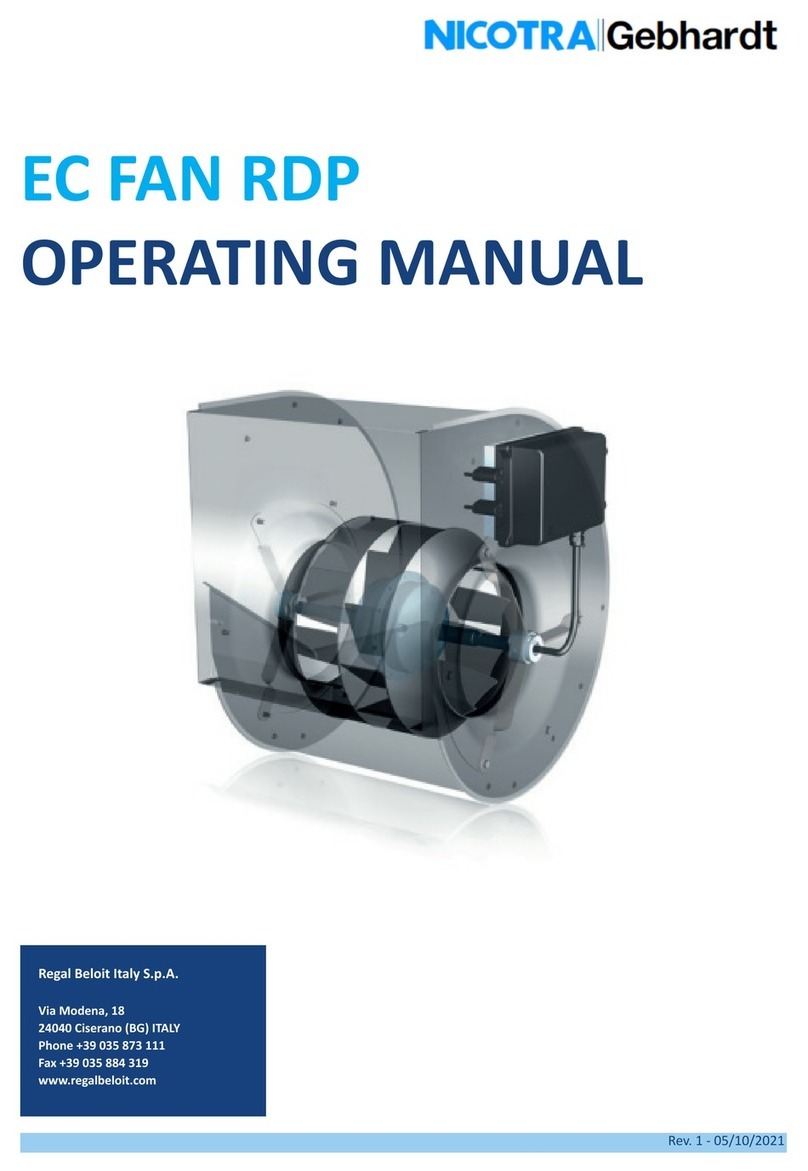
Nicotra Gebhardt
Nicotra Gebhardt EC FAN RDP operating manual

U.S. Sunlight
U.S. Sunlight All Purpose Ventilator Installation and mounting guide
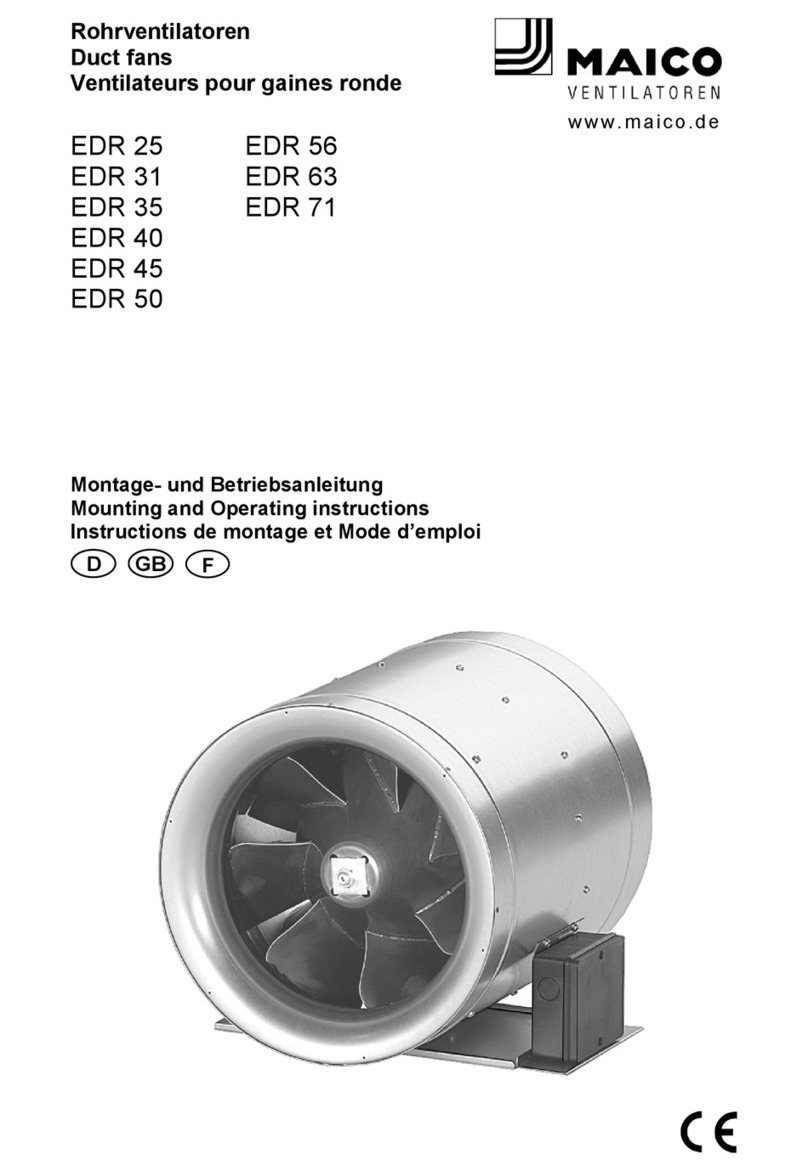
Maico
Maico EDR 25 Mounting and operating instructions
